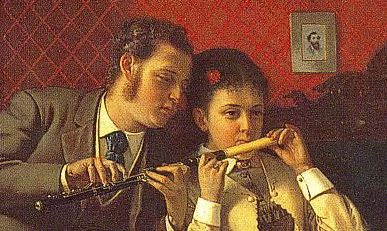

This section is fairly technical. We discuss the number and variety of keys that appeared on the 19th century simple system flute. Some may wish to just quickly look at the pictures and then go to the next section on playing characteristics and performance.
We use simple system flute (or sometimes, just the old flute) to mean a conical-bore flute with exactly six open holes, which when opened one by one produce a major scale (D major in the case of the standard size flute), and with, let's say, at least four closed-standing keys (and no open-standing keys) on the body. The terms keyed flute or multi-keyed flute are somewhat more general. We would include the Tromlitz flute shown in the classical flutes section as a multi-keyed flute, but hesitate to call it a simple system instrument because of the open c'' key; it is Tromlitz's system.
A flute with one key may be called simply a one-key flute. We do not wish to include it as simple system flute, because the fingering used on it is based on a different principal (forked fingerings) than flutes with keys (where the keys are to be used whenever possible).
On early 19th century flutes, other than some English and Viennese instruments, one can ignore the keys and play the flute as if it were a one-key flute, whenever convenient or necessary, employing the one-key fingerings that use only the D# key. But the flutes may be less easy to play in tune than 18th century one-key flutes when played that way. Because the F key(s) were available, for example, a maker might not take much care to ensure that the the old forked fingering 1234-6 works well.
Keys are named for the note they produce when in use. But holes are named for the note that sounds when they are uncovered. The Bb key covers the Bb hole, and similarly for any closed-standing key. But. e.g., the low C# key covers the D hole when closed.
We have already said that, in giving the total number of keys, we like to count extra levers (Tromlitz levers) as keys. In brief, any part of a key or mechanism designed for a finger to press will be counted as a key in our descriptions below.
In 1800, we find the small closed-standing keys for D#, F, G#, and Bb in use everywhere. The C-foot with its extra two open-standing keys was well known, though its popularity varied from country to country. The next most common key was probably the long F key. A second Bb key, or a second lever, was known; it is sometimes called the long Bb key. Several kinds of C keys (for c'' and c''') had been or would soon be introduced; the one that would become most common, for RH1, will be called the long C key . And the B-foot, with an extra open-standing key for low b, had appeared or would soon appear in Vienna. All these keys were still "extra". Most students and amateurs played one-key flutes in 1800 (and well beyond that).
Flutes from the early 19th century will have some of the above keys, and maybe all. The most common configurations circa 1820 are:
If we add one-key flutes, the list includes the types one is most likely to run into, circa 1820, but one can always find others. There are for example, five-key flutes with a C#-foot and D#, F, G#, and Bb keys, and seven-key flutes with a C#-foot and D#, F, G#, Bb, long F, and long C keys. (One can wonder why the foot would stop at c'#.) There are seven-key flutes with a C-foot and D#, F, G#, Bb, and long C keys. The last two types in our list, with the B-foot, would be found in Germany and Vienna, and were becoming common there in the 1820s.
Here are photos of flutes of each of these types. But it will be difficult to see the exact positions of the keys. (More details of these instruments will eventually be found on other pages of this site.)
A four-key flute by Willis and Goodlad, London, c.1830:

A five-key flute by Tulou, Paris, c.1835:

A six-key flute by W. H. Potter, London, c.1815:

A six-key flute by Braun, Mannheim, c.1820:

An eight-key flute by E. Riley, New York, c.1820:

A nine-key flute by Monzani, London, c.1819:

A nine-key flute by Koch, Vienna, c.1839:

A ten-key flute by Streitwolf, Göttingen, c.1830:

The four-key flute, and even the six-key English type, though common enough, should not be considered state-of-the-art for the 1820's. The others, though not necessarily the fanciest models available, were among the better and up-to-date instruments when they were made.
Note that the flute by Koch is of a three piece construction (counting the head joint assembly as one piece). After 1830 or so, the vast majority of Continental B-foot simple system flutes were made on this pattern: the lower center (heartpiece) and the foot joint were combined. The long low B key for LH4 has the most reliable action and is safest from damage when it is mounted on this kind of lower joint and not solely on a detachable foot joint, as on the Streitwolf. Flutes without B-foots continued to be, primarily, of the older construction.
On some early instruments by S. Koch, the touch of the low b key is given to the right hand thumb, as on the flute (c.1815) on the bottom in the photo below (seen from the audience side). This is awkward to use, since that thumb must help support the flute. The other flute, with the touch for the b key just above that for the long F key, is also by Koch, c.1820.

The flute offerings of the Schott firm of Mainz in 1825 included one and four-key flutes with corps de rechange and four, eight, and nine-key flutes with tuning slides, the last to low b. Here is the list, taken from Anthony Baines' Woodwind Instruments and their History, Dover, 1991. (Click for details and source.)
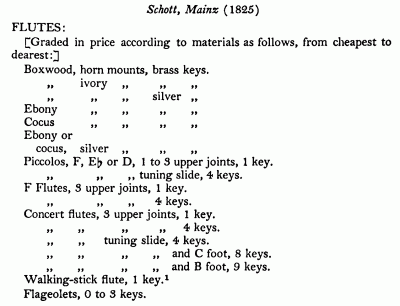
Before 1830, a key solely for the purpose of the third octave trill e''' over d''' had been introduced, and would soon be common on better German flutes. (The idea for this and other trill keys can be traced back to 1811, to a trill key of J. N. Capeller, which was said to be useful for C#/B, D/C#, and e'''/d''' trills. It is unlikely that it was truly satisfactory for all these uses.)
As implemented circa 1830, this was a long key for RH1, with a touch close to those for the long C and long Bb keys, that controlled a hole far up the flute, close to the head joint. If this key appears with the ten keys mentioned above, we have a type of 11-key flute than was very common in 19th century Germany. Here are several examples: eleven-key flutes by Hill (London, c.1929), Liebel (Dresden, c.1850), and Euler (Frankfurt, c.1880). The latter two flutes are of the three piece construction; the Hill gives the low b key to RH4 and retains the four piece construction.

By 1820, other keys had been or would soon be introduced to duplicate the duties of the five keys for notes D#, F, G#, Bb, and C outside of D major. The flute below is much later than 1820; it is a 15-key flute by Maino e Orsi, Milano, c.1900. But each and every key that appears on it can already be found on some flutes made before 1830 (though I don't know of an instrument that early which actually has all of these keys at the same time).

This flute has two keys for every note outside D major. There is a long and a short form of each key. Even the D# key has a (very) long extra lever, for the left hand thumb. The flute also has the e'''/d''' trill key and a Bb foot.
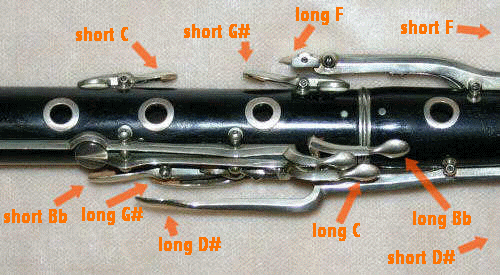
Karl Grenser, writing in 1824, attributes the introduction of an extended foot and a key for low b to the Viennese, but he gives no information on when it was first done. But by 1815 and 1820, the Viennese makers Trexler and Koch had in fact made flutes with 16 keys and long foot joints that extended to g of the violin! These long flutes were dubbed panaulons and the virtuoso Georg Bayr wrote a tutor for the instrument in 1823. Here is a panaulon by Ziegler of Vienna, c.1830. (Photo by David Dahl.)
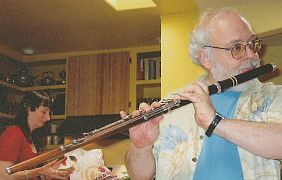
This flute has a straight lower section, although many G-foot flutes were made with the foot section curved back towards the head, rather like a bassoon. There are two F keys, two Bb keys, and two G# kyes, and the e'''/d''' trill key. RH4 controls the low c'#, c', and b keys. LH4 controls the long bb and a keys; and the left hand thumb controls the even longer g# and g keys.

(The head joint shown is a replacement for the lost original, by Michael Hubbert, who also took the photograph. This is the same flute, just in black and white.)
Numerous extra trill keys can be found on some simple system flutes. The illustration below is from the Rampone catalog, c.1920, to be found elsewhere on this site.

There are six key touches for RH1 on the extreme right, all of which are used primarily for trills. These include the common long C, (long) extra Bb, and high D trill keys.
Simple system flutes sometimes took advantage of the mechanism ideas seen on the Boehm flute. This would have eventually happened without Boehm, but the introduction of his flute spurred innovations on all types of flutes. In particular, some keys on some simple system flutes were mounted on axles with needle springs. This was most significant for the foot joint, I would say; the action of the old form of open-standing keys is often unreliable (particularly on antique flutes as they survive today).
Below is a 12-key flute from Carl Fischer, NY, c. 1900. It is also stamped "France" [sic, i.e. with the quotes]. All keys use flat springs except those on the foot joint, which are mounted on axles.

There are unusual second C and Bb keys on the Fischer, but also a Tulou F# key. The latter is the small key mounted lengthwise on the lower center that crosses over the short F key. The touch is for RH4. Its sole purpose was to sharpen the f'# and f''#, which are often flat, especially on French-style flutes where the forked fingering 1234-6 for F natural was still in use. (But the F#'s still tend to be flat on flutes where the forked fingering for F cannot be used, probably in part because several notes and fingerings of the simple system flute depend on the 5th hole not being too large.) The Tulou F# key opens a small hole between finger holes 4 and 5, and allows F# to be played piano without danger of being flat.
Tulou introduced a model of flute he termed the flûte perfectioneé circa 1840, as part of his effort to defend the old flute against the Boehm flute. All keys are on axles with needle springs on the flûte perfectioneé by Nonon (Paris, c.1860) shown below.
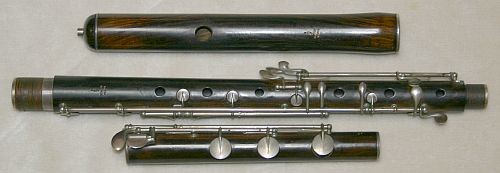
Several trill keys and the F# key are provided. By our method of counting every touch as a key, it has 13 keys, included a low b key for LH4. An unusal feature is a second C key under the flute for the left hand thumb, next to a Bb key and a C hole.
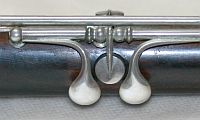
In spite of the mechanism, this is a simple system flute. The six open holes are the same six holes, so-to-speak, as on the French five-key flute. The flute plays very well, with the same basic sound as less elaborate French flutes.
More technical information on mounts and keys will appear in other sections of this site.
Flutes by the firm of H. F. Meyer (1814–1897) of Hannover were very much admired and were much imitated. Many anonymous German flutes stamped 'nach Meyer' may be found. The term 'Meyer system' has become, inappropriately in my opinion, almost synonymous with (late 19C) 'German-style simple system' (with at least eight or nine keys).
Flutes by the firm of J. J. Ziegler (1795–1858) of Vienna were also very much admired and much imitated—in different parts of Europe, including Italy. The term 'Ziegler system' is common in those parts, to mean 'Viennese-style simple system'.
In 1885, Maximilian Schwedler introduced a new model flute with an `improved bore' and innovative trill keys; these were constructed by Carl Kruspe of Liepsig. The center peice (of three sections) contained all six finger holes, like the Tulou flûte perfectioneé. The embouchure hole has raised cusps on either side (though this was not new to his model). The flute below is stamped SCHWEDLER, and also Wurlitzer in smaller letters on the back of the head joint. It was probably made after 1900.
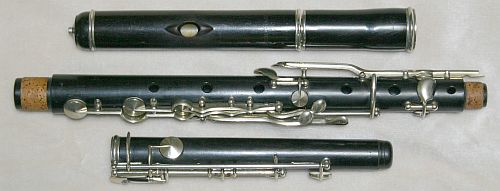
Schwedler flutes can be quite loud, but in spite of a different sound and mechanism, these flutes are still simple system flutes, with six open holes and only closed-standing keys on the body.
Click here to see Meyer, Zeigler, and Schwedler system flutes along with other types in use in circa 1910 Germany.
Some 19th century conical flutes are fitted with ring keys
or open-standing keys. This would include Siccama system flutes and Schwedler's
reform flutes. These we do not include as simple
system flutes, and they will be discussed in the section
in further developement of the simple system flute.
The simple system flute continued to be used well into the 20th century. See the catalog offerings of the Zimmermann and Rampone firms, etc. Simple system flutes were still being used in some major orchestras c.1900, but many poor quality instruments were being mass produced, and often were not stamped with the name of a manufacturer. Here is a small pile of anonymous instruments from the 1880–1930 period, including three German B-foot instruments (two with ivory heads stamped "nach Meyer"), a one-key French flute, and a six-key flute of possible English origin. Some anonymous instruments are fine players and can give much pleasure. These particular instruments, in spite of their resemblance to real flutes, are wretched players. It is not clear if they were always wretched, or if natural causes, mistreatment, or maladjustment has changed them since they were made.

Speaking of wretched players, here is a photo of an ensemble from the 1940's. It is difficult to see the details of the flute here, but it is a nine- or possibly ten-key simple system instrument that Moe is playing. Click here for more.
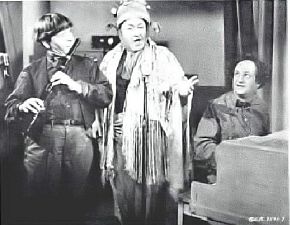
(Some younger viewers may not recognize the comedy team of The Three Stooges. They have no real connection to music, though Larry was a fine violinist.)
